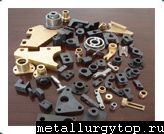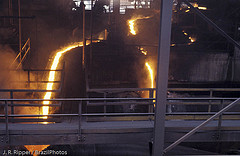Изготовление холодного и огнестрельного оружия
 Изготовление холодного и огнестрельного оружия, шлемов, кольчуг и орудий труда
Изготовление холодного и огнестрельного оружия, шлемов, кольчуг и орудий труда
В Древней Руси уклад служил для изготовления холодного и огнестрельного оружия, шлемов, кольчуг и орудий труда. В XVIII-XIX веках из уклада изготовляли топоры, ножи, серпы и другой сельскохозяйственный инвентарь. Уклад кустарной выделки был вытеснен процессом изготовления металла в кричных горнах (из чугуна) на железоделательных заводах. Невелика была производительность таких горнов: около 0,5 килограмма железной крицы в час.
Стремление получить больше металла заставило увеличить размеры сыродутных горнов, подавать в них больше воздуха. Так появились наземные печи - домницы. Дутье усилили с помощью воздуходувных мехов, приводимых в движение вначале животными, а затем с помощью водяного колеса. Рост домниц в высоту, подача в них большого количества воздуха интенсифицировали процессы горения и восстановления, что привело к неожиданным результатам. Вместо привычной полугустой крицы на дне печей появился жидкий металл, который, остывая, становился хрупким и под ударами молота разбивался на куски. Это был чугун - сплав железа с углеродом. Процесс получения чугуна назвали доменным.
Конечно, доменные печи (их появление относят к XIV веку) - прогресс в металлургии. В них стали получать значительно больше металла. Первые металлургические заводы на Руси начали строить в XVI-XVII веках рядом с Тулой, Каширой, Серпуховом, Новгородом. Доменные же печи были построены впервые в 1632 году на Городищенском заводе вблизи старинного русского поселения Тулы у реки Тулицы. Все русские железоделательные заводы в конце XVIII века могли производить за год около 150 тысяч пудов железа.
Петр I заложил верфи для строительства кораблей «первого флота российского» на берегах рек Воронежа и Дона. Корабельной сосны и других пород деревьев хватало - вокруг были дремучие леса. Царь думал о нехватке железа. Надежда на тульские заводы слабая у них своих дел по горло.
Вихрем домчали. Дотошный царь обошел все рудные шурфы и ямы, осмотрел местность. Остановился у подножия холма. Здесь позже по указанию царя возвели липецкие казенные заводы. Доменные печи выплавляли чугун. Здесь же выделывали железо. В течение года выпускали полтысячи корабельных пушек, якоря, пистолеты, мушкеты, ядра.





What You Don't Need to Succeed
 In this post you are going to discover the secret of becoming a successful contractor via the most direct path.
In this post you are going to discover the secret of becoming a successful contractor via the most direct path.
Yet before I get into that, let me talk briefly about the main currency of contracting in the UK. There are three forces at work. In order of importance they are: skills, experience and qualifications. These the three basic things that you need to align with a client's expectations in order to get a contract.
Let's take these in reverse order starting with qualifications.
Qualifications in IT are a joke. Having a degree can give you a competitive edge but it is by no means essential. It doesn't even seem to matter what subject your degree is in. I've worked with people with degrees in Metallurgy, Marine Biology and Music before. Then we have the so called professional qualifications. These are ridiculously trivial when compared to other professions.
You can pick up an in MCSE less than a month and a Sun Certified Enterprise Architect course can be done in 14 days. A Cisco Certified Network Professional certification will take you 2 weeks.
By comparison nurses have to train for 3 years and fire fighters train for 2 years before they pass their probationary period. Basic training to become a soldier takes around 6 months.
Therefore it is not surprising that IT qualifications are not taken very seriously by employers. If you have them, then it doesn't hurt, but they are pricey to obtain and they go out of date fast.
Never in all of my years working in IT have my qualifications been checked. If I had been less honest, I could have given myself a few more degrees and half a dozen made up certifications.
So what about experience?
Everything changes so fast in IT that anything more than 5 years experience tends to be mostly irrelevant, even in the same skill set. You might have been working with the same technology for 15 years, but the chances are you were using it totally differently five years ago.
Even touchy–feely management skills come in and out of fashion as quick as David Beckham's underpants. It's not really how much experience you have that counts, but having relevant experience.
Again, just like qualifications, your experience is never verified. People just don't have the time. If you sound convincing enough, then you would likely be taken a face value.
Lastly we come to your technical skills. Most skills being sought by clients can either be learned in hours or at most a few days. That's assuming of course that you have some basic levels of IT competence.
For more complex subjects, training courses can often teach you the subject in a week or two. If the skill is new to you, you can cram a lot on it before a contract and carry on with a reasonable degree of credibly. It is even possible to pass a technical test this way. You may even beat someone who actually has more knowledge and experience, if they have not brushed up before the test.
That of course is assuming you even have a technical test. These are rarer than you would expect, presumably due to the lack of time people have to set them up, let alone assess them. I have certainly come across contracts that you could completely blag. As long as you were able to hit the ground running, no one would even know. Even if you can't there's a chance that it would take months before they figure it out.
So in conclusion, none of the three sacred CV areas are actually much of a hurdle. The point is, the actual skills that you need to really make it in this game are never listed on your CV. It is surprising how few people realise this and they spend their entire career beefing up those three areas.
Instead the real power skills involve understanding the market, salesmanship and having a good strategy. If you want to survive in the world of contracting you need to understand how to work with people and deal with office politics. No one has yet created a diploma for those skills. You will need to look for other resources, such as the ones available on my site to help you there.





Calculation of Phase Diagrams
 This excellent book is probably the first comprehensive guide to the CALPHAD method. CALPHAD is an acronym that was coined in the early 1970s and stands for CALculation of PHAse Diagrams.
This excellent book is probably the first comprehensive guide to the CALPHAD method. CALPHAD is an acronym that was coined in the early 1970s and stands for CALculation of PHAse Diagrams.
The CALPHAD method is based on the fact that a phase diagram is a representation of the thermodynamic properties of a system. Thus, if the thermodynamic properties are known, it is possible to calculate the multi–component phase diagrams. In other words, thermodynamic descriptions of lower–order systems (e.g., the Gibbs energy of each phase) can be combined to extrapolate higher–order systems.
In metallurgical engineering, for example, the CALPHAD method is invaluable when it comes to understanding the relationship between the chemical composition of an alloy (typically based on complex higher–order systems), the processing conditions, the resulting microstructure, and the alloy's final properties. In addition, most alloys undergo one or more phase transformations during use. Such phase transformations can often be understood through the use of phase diagrams (and which now can be calculated, thanks to the CALPHAD method).
The book covers the history of the CALPHAD method; the laws and basic concepts of thermodynamics (enthalpy, heat capacity, chemical equilibrium, Gibbs energy, etc); various experimental techniques to measure thermodynamic quantities and to construct phase diagrams; thermodynamic models for solutions and compound phases (stoichiometric compounds, random substitutional models, sublattice models, ionic liquid models, and aqueous solutions); phase stabilities; short–range and long–range ordering models; the role of magnetic Gibbs energy; computational methods and thermodynamic optimization of phase diagrams; as well as the coupling of thermodynamics and kinetics.
Finally, a number of important practical examples where the CALPHAD method was successfully applied are given and described in detail. The examples include titanium–based Ti–6Al–4V alloy, aluminum casting alloys, corrosion–resistant duplex stainless steels, nickel–based superalloys, high–speed steels, sigma–phase formation, micro–alloyed steels, NiAl–based and TiAl–based intermetallic alloys, magnetic alloys, high–strength cobalt–nickel steels, slag and slag–metal equilibria, chemical vapor deposition processing, hot salt corrosion in gas turbines, and the effect of radiation on the precipitation of silicides in nickel–based alloys.




